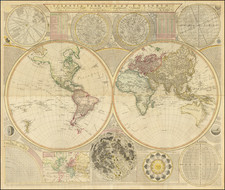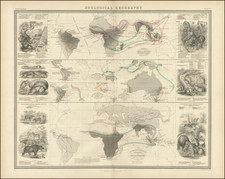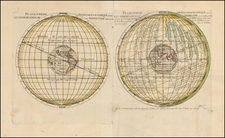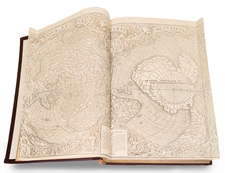Striking example of Waldseemuller's Ptolemaic map, from the 1513 Strasbourg edition of Ptolemy's Geographia. Rodney Shirley refers to the map as, "one of the most attractive Ptolemaic maps ever produced."
The Strasbourg edition is widely considered the most important edition of Ptolemy's Geographia. This edition included two world maps, one modern map and this spectacular map of the world as known to Ptolemy, incorporating 8 windheads and other remarkable decorative embellishments. Depicted in the traditional modified conical projection, the map is the first attempt since the Ulm edition of 1482 and 1486 to provide such rich bold embellishments.
The basic cartography of the map follows Ptolemy, although Waldseemuller does open up the Indian Ocean in the East and also eliminates the land to the south of the Indian Ocean which appeared in earlier maps. A very early use of markings of longitude and latitude, along with notes on the Climates in the left margin beyond the map. A nice example of this increasingly rare world map.
Martin Waldseemüller (c. 1475-1520) was a sixteenth-century cosmographer best known for his 1507 world map in twelve sheets, the earliest surviving map to include the name “America.” He was an influential mapmaker during his time whose work affected many of his contemporaries and successors. Waldseemüller was born near Freiburg, in what is now southwestern Germany. His family moved to Freiburg proper when he was young and he attended university in the city beginning in 1490.
Waldseemüller gathered information about the New World discoveries and geography from St.-Dié des Vosges in Lorraine, where he was a professor of cosmography under the patronage of René II, Duke of Lorraine. He was a member of an intellectual circle who produced work from the St.-Dié Press. However, the press failed when the Duke died, and Waldseemüller moved to Strasbourg.
He is best known for the 1507 map and another world projection, the Carta Marina published in 1516. He also published an edition of Ptolemy in 1513, in collaboration with Johann Schott, a friend from Freiburg and St.-Dié. Besides his innovative use of the toponym “America”, Waldseemüller was the first to create such a large printed world map, the author of the earliest known printed globe gores, the first to create a published collection of modern maps, and one of the first to create maps from ground measurements. He was knowledgeable in surveying methods and designed a quadrant and other instruments. He returned to St.-Dié late in life as canon, although he continued to return to Strasbourg for work and for carnival. He died in St.-Dié in 1520.
Waldseemuller is generally credited with having named the continent of America, based upon the then current belief that Amerigo Vespucci had been the first modern explorer to reach the continent of America in 1497, during the first of four expeditions to America which were then credited to Vespucci between 1497 and 1504. The report which described the 1497 expedition is now generally believed to be a forgery. Later in his career, Waldseemüller elected not to use the toponym for the continents, preferring to leave them unnamed. However, the name had been taken up by his contemporaries, in large part due to the influential nature of Waldseemüller’s earlier works.

![[World] Generale Ptholemei By Martin Waldseemüller](https://storage.googleapis.com/raremaps/img/small/94338.jpg)








![[World] Air France --](https://storage.googleapis.com/raremaps/img/small/93647.jpg)




